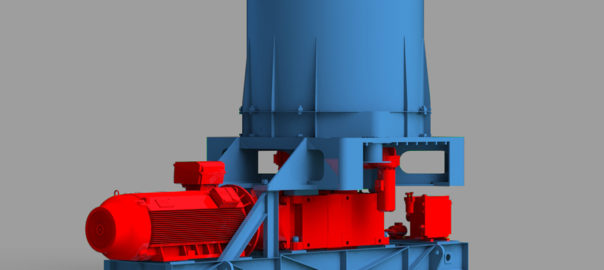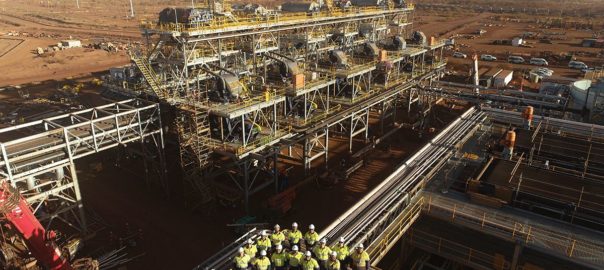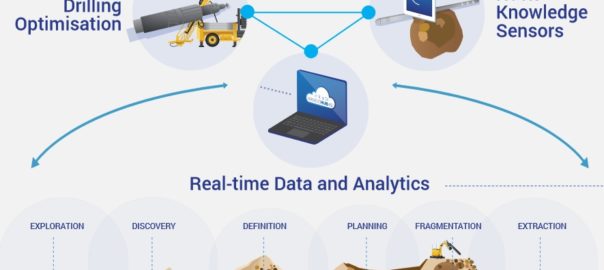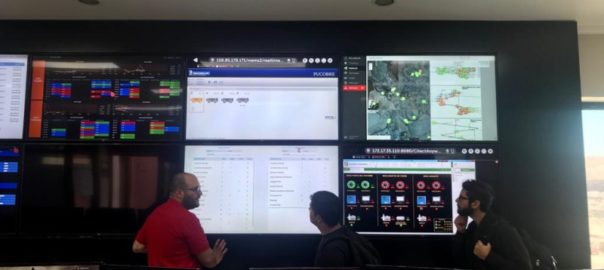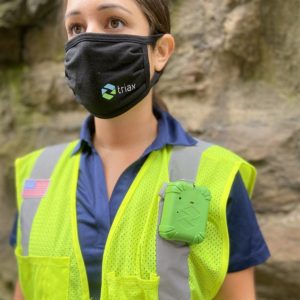A lot has been made of the potential of high pressure grinding rolls (HPGRs) to facilitate the dry milling process many in the industry believe will help miners achieve their sustainability goals over the next few decades, but there is another novel technology ready to go that could, according to the inventor and an independent consultant, provide an even more effective alternative.
Eccentric High Pressure Centrifugal Comminution (eHPCC™) technology was conceived in 2013 and, according to inventor Linden Roper, has the potential to eliminate the inefficiencies and complexity of conventional crushing and/or tumbling mill circuits.
It complements any upstream feed source, Roper says, whether it be run of mine (ROM), primary crushed rock, or other conventional comminution streams such as tumbling mill oversize. It may also benefit downstream process requirements through selective mineral liberation, which is feasible as the ore is comminuted upon itself (autogenously) in the high pressure zone via synchronous rotating components. Significant product stream enrichment/depletion has been observed and reported, too.
As IM goes to press on its annual comminution and crushing feature for the April 2021 issue – and Dr Mike Daniel, an independent consultant engaged by Roper to review and critique the technology’s development, prepares a paper for MEI Conferences’ Comminution ’21 event – now was the right time to find out more.
IM: Considering the Comminution ’21 abstract draws parallels with HPGRs, can you clarify the similarities and differences between eHPCC and HPGR technology?
MD & LR: These are the similarities:
- Both offer confined-bed high-pressure compression comminution, which results in micro fractures at grain boundaries;
- Both have evidence of preferential liberation and separation of mineral grains from gangue grains at grain boundaries; and
- Both have an autogenous protective layer formed on the compression roll surfaces between sintered tungsten carbide studs.
These are the differences:
- eHPCC facilitates multiple cycles of comminution, fluidisation and classification within its grinding chamber, retaining oversize particles until the target product size is attained. The HPGR is a single pass technology dependent on separate materials handling and classification/screening equipment to recycle oversize particles for further comminution (in the event subsequent stages of comminution are not used);
- Micro factures around grain boundaries and compacted flake product that are created within HPGRs need to be de-agglomerated with downstream processing either within materials handling or wet screening. In some instances, compacted flake may be processed in a downstream ball mill, whereas, in eHPCC, preferential mineral liberation is perfected by subsequent continuous cycles within the grinding chamber until mineral liberation is achieved within a bi-modal target size (minerals and gangue). The bi-modal effect differs from ore type to ore type and the natural size of the minerals of interest;
- The preferential liberation of mineral grains from gangue grains generally occurs at significantly different grain sizes, respectively, due to the inherent difference in progeny hardness. eHPCC retains the larger, harder grains, hence ensuring thorough stripping/cleaning of other grain surfaces by shear and attrition forces;
- eHPCC tolerates rounded tramp metal within its grinding chamber, however does not tolerate high quantities of sharp, fragmented tramp metal that create a non-compressible, non-free-flowing bridge between roll surfaces, which risks the damage of liner surfaces;
- The coarse fraction ‘edge effect’ common in HPGR geometry is not an issue with eHPCC. In fact, the top zone of the eHPCC grinding chamber is presumed to be an additional portion of the primary classification zone within the grinding chamber. The oversize particles from the internal classification process are retained for subsequent comminution;
- The maximum size of feed particle (f100) entering the eHPCC is not limited to roll geometry as is the case with HPGRs (typically 50-70 mm). eHPCC f100 is limited to feed spout diameter (for free flow) and dependent of machine size ie eHPCC-2, -5, -8 and -13 are anticipated to have f100 60 mm, 150 mm, 240 mm and 390 mm, respectively. The gap between rolling surfaces is greater than the respective f100; and
- eHPCC technology shows scientifically significant product stream enrichment.
IM: What operating and capital cost benefits do you envisage when compared with typical HPGR installations?
MD & LR: Both operating and capital cost benefits of the eHPCC relative to HPGR technology are due to the eHPCC not requiring the pre-crushing and downstream classification equipment required by HPGRs.
The eHPCC operating cost benefits are associated with eliminating maintenance consumables, downtime, reliability issues and energy consumption associated with the equivalent HPGR downstream equipment listed above.
The eHPCC capital cost benefits are associated with eliminating the real estate (footprint) and all engineering procurement and construction management costs associated with the equivalent HPGR upstream/downstream equipment listed above. eHPCC flowsheets are likely to be installed as multiple ‘one-stop’ units that maintain high circuit availability due to ongoing cyclic preventative maintenance.
IM: Where has the design for the eHPCC technology come from?
LR: It was invented in early 2013 by me. I then pioneered proof-of-concept, prototyping, design and development, culminating in operational trials in a Kazakhstan gold mine in 2020. A commercial-grade detailed design-for-manufacture has since been undertaken by a senior team of heavy industry mechanical machine designers and engineers.
IM: In your conference abstract, I note that the eHPCC technology has been tested at both laboratory and semi-industrial scale with working prototypes. Can you clarify what throughputs and material characteristics you are talking about here?
LR: The first iteration of the technology, eHPCC-1, was tested at the laboratory scale from 2013-2015. This proof-of-concept machine successfully received and processed magnetite concentrate, copper-nickel sulphide ore, alkaline granite, marble and a wolfram clay ore dried in ambient conditions. The typical throughput was between 200-400 kg/h depending on the feed size, particle-size-reduction-ratios (dependent of grain size) and target product size. The feed size was limited to a maximum of 25 mm to ensure free flow of feed spout.
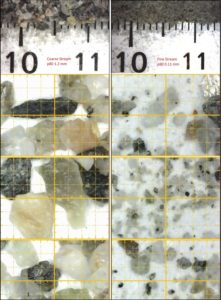
MD & LR: From 2016-2020, we moved onto the semi-industrial scale testing with the eHPCC-2 (two times scaled up from eHPCC-1). This was designed for research and development (R&D) and tested on magnetite concentrate, alkaline granite, and hard underground quartz/gold ore. The throughput capabilities depended on the geo-metallurgical and geo-mechanical properties of feed material, such as particle size, strength, progeny (grain) size and particle size-reduction-ratios (subject to confined bed high pressure compression). Larger-scale machines are yet to be tested against traditional ‘Bond Theory’ norms.
The eHPCC, irrespective of the outcomes, should be evaluated on its ability to effectively liberate minerals of interest in a way that no other comminution device can do. The maximum feed size, f100, at the gold mine trials was limited to 50 mm to ensure free flow through the feed spout. R&D culminated in pilot-scale operational trials at the Akbakai gold mine (Kazakhstan), owned by JSC AK Altynalmas, in 2020, where SAG mill rejects of hard underground quartz/gold ore were processed. The mutual intent and purpose of the tests was to observe and define wear characteristics of the eHPCC grinding chamber liners (roll surfaces). These operational trials involved 80% of the feed size being less than 17 mm and a variety of targeted product sizes whereby 80% was less than 1 mm, 2 mm, 2.85 mm and 4.8 mm. The throughput ranged from 1-5 t/h based on the size.
IM: What throughputs and material characteristics will be set for the full-scale solution?
LR: There will be a select number of standard eHPCC sizes. Relative to the original eHPCC-1, the following scale-up factors are envisaged: -2, -3, -5, -8, and -13. These are geometrical linear scale-up factors; the actual volumetric capacity is a cube of this factor, with adjustments for centripetal acceleration. Currently -13 times seems to be the maximum feasible size of the present detailed design philosophy, but there are no foreseeable limitations in terms of feed materials with exception to moist clay. Clay was successfully processed after drying the feed in ambient temperatures during testing. Further testing of moist clays blended with other materials that can absorb the moisture as they comminute would be desirable.
IM: Other HPGRs can also be equipped with air classification technology to create dry comminution circuits. What is the difference between the type of attrition and air classification option you are offering with the eHPCC?
MD & LR: Two modes of comminution occur in the particle bed of eHPCC repetitively and simultaneously. First, confined bed pressure compression breakage occurs at a macro level that promotes shear/compression forces greater than the mineral grain boundaries. Second, Mohr-Coulomb Failure Criteria (shear/attrition) that completes the separation of micro fractures on subsequent cycles takes place.
The nip angle between the rotating components of eHPCC technology never exceed 5°. During the decompression and fluidisation portion of the cycle, the softer species – which are now much smaller – are swept out of the fluidised particle bed against centrifugal and gravitational forces by process air. The larger species, influenced by centripetal acceleration, concentrate at the outer diametric and lower limits of the conical rotating grinding chamber, continuing to work on each other during each subsequent compression phase.
HPGRs are limited to one single-pass comminution event, requiring downstream external classification and subsequent recycling/reprocessing of their oversize and/or flake product.
IM: How will it improve the mineral liberation and separation efficiency compared with other grinding solutions that combine both?
MD: eHPCC technology could compete with the Vertical Roller Mill and Horomill, however, eHPCC is likely to be more compact with high intensity breakage events contained within the all-inclusive system of breakage, classification and removal of products.
IM: When was it most recently tested and over what timeframe?
LR: The eHPCC-2 pilot plant was mobilised, setup and commissioned in March 2020, but its operation was suspended until June 2020 due to COVID-19 quarantine restrictions and a need to cater to abnormal amounts of ball fragments in the feed, the latter of which pushed the treatment of tramp metal to the extreme. The machine operated for the months of June and July using liners constructed of plasma transferred arc welded (PTAW) tungsten carbide (TC) overlay. During this period, a total of 795 t was processed at various targeted product sizes, with, overall, an average throughput of 3 t/h (nominally 265 operating hours) processed.
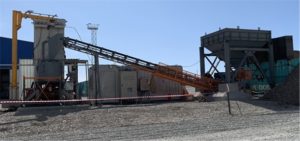
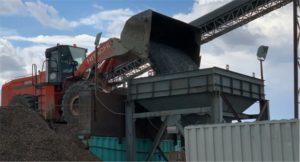
The PTAW-TC overlay was deemed unsustainable as it was consumed rapidly and demanded continuous rebuilding due to the high pressure intensive abrasive wear on the convex cone. The pilot plant operation was mostly suspended during the month of August while an alternative tungsten carbide studded liner, analogous to HPGR studded rolls, was manufactured for simulating a trial of this studded liner philosophy. The studded liner philosophy was operated in the eHPCC-2 in Kazakhstan for sufficiently long enough to ascertain the creation of the autogenous protective wear layer of rock between the studs, with the simulation trial deemed a success. The design philosophy shall be adapted on the commercial-grade eHPCC.

The pilot plant was demobilised from the Akbakai site laydown area on September 10, 2020, to release the area for construction of a non-related plant expansion. The operational experiences of the pilot plant at Akbakai provided valuable knowledge and experience pertaining to mechanical inertia dynamics and design for eliminating fatigue within eHPCC components.
IM: Aside from the test work on trommel oversize at the Kazakhstan gold mine, where else have you tested the technology?
LR: eHPCC has no other operational experiences so far. Investment and collaboration from the industry to progress the commercialisation of eHPCC is invited. The commercial-grade eHPCC-2.2 is designed and ready for manufacture.
IM: Is the technology more suited to projects where multiple streams can be produced (fines, coarse piles, etc)?
LR: eHPCC is configurable to meet the demands and liberality of a diverse spectrum of feed materials and the potential downstream extractive processes are complementary to eHPCC product streams. Therefore, it would be incorrect to categorise it as more suitable in any one niche; it is configurable, on a case-by-case basis, to meet the liberality of the specific progeny of the feed.
IM: What energy use benefits do you anticipate by creating a one-step comminution and classification process over the more conventional two-step process?
MD & LR: The energy saving benefits include:
- Elimination of tumbling mill grinding media consumption;
- Elimination of the liberal wastage of randomly directed attrition and/or impact events that indiscriminately reduce the size of any/all particles (gangue or precious mineral) with the conventional tumbling mill; and
- Elimination of energy consumption of the materials handling systems between the various stages of comminution and classification, be it dry belt conveying, vibrating screens, classifiers, cyclone feed pumps, cyclones and their respective recirculating loads that can be upward of 300% of fresh feed.
IM: Do you anticipate more interest in this solution from certain regions? For instance, is it likely to appeal more to those locations that are suffering from water shortages (Australia, South America)?
MD & LR: We suspect the initial commercialisation growth market to be from base metals producers seeking to expand or retire existing aged/tired comminution classification capacity, followed by industry acknowledgement of the technology’s potential to shift the financial indicators of other potential undeveloped projects into more positive territory. This latter development could see the technology integrated into new projects.
In general, the technology will appeal to those companies looking for more efficient dry comminution processes. This is because it offers a pathway to rejection of gangue at larger particle sizes, early stream enrichment/depletion and minimal overgrinding that creates unnecessary silt, which, in turn, hinders or disrupts the integrity of downstream metallurgical extraction kinetics, and/or materials handling rheology, and/or tailings storage and management.
LR: There are a number of rhetorical questions the industry needs to be asking: why do we participate in the manufacture and consumption of grinding media considering the holistic end-to-end energy and mass balance of this (it’s crazy; really why?)? Why do we grind wet? What are the barriers preventing transition from philosophising over energy efficiency, sustainability etc and actually executing change? Who is up for a renaissance of bravely pioneering disruptive comminution and classification technology in the spirit of our pioneering forefathers?
The more these questions are asked, the more likely the industry will find the solutions it needs to achieve its future goals.
Dr Mike Daniel’s talk on eHPCC technology will be one of the presentations at the upcoming Comminution ’21 conference on April 19-22, 2021. For more information on the event, head to https://mei.eventsair.com/comminution-21/ International Mining is a media sponsor of the event







